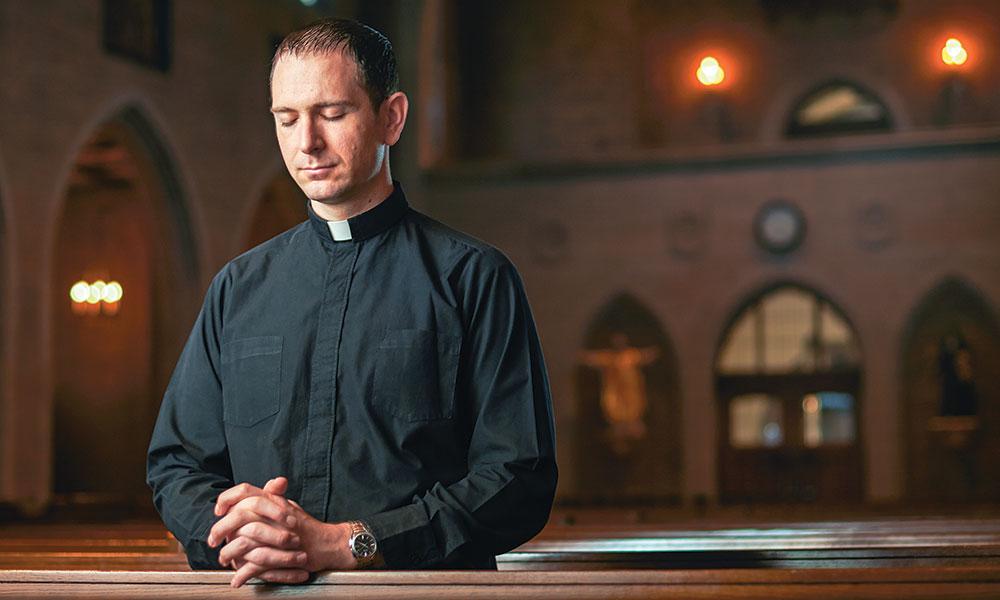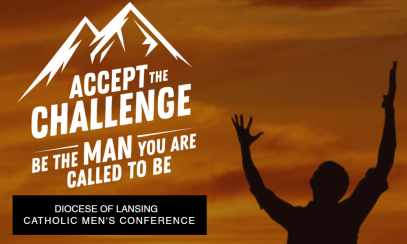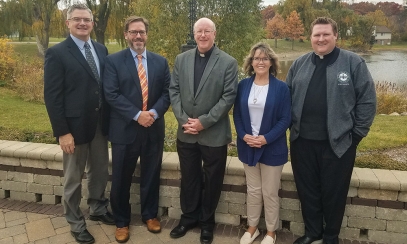
Eight Questions for the Chairman: Meet Father Mathias Thelen
Father Mathias Thelen is the chairman of the Realign Resources for Mission (RRM) Committee. The 37-year-old is a native of the village of Fowler. He was ordained to the holy priesthood in 2010. He served in several parishes before being appointed pastor of St. Patrick in Brighton in 2017. In the summer of 2019, Bishop Boyea asked him to chair the newly created RRM Committee.
How did you feel when Bishop Boyea asked you to head up the Realign Resources for Mission Committee?
At first, I was honored that the bishop would ask me to lead such a significant effort to advance the mission of Christ in the diocese. But then I quickly thought to myself, “How in the world will I have time for this?” So as a result, I didn’t say yes right away and took it to prayer. After receiving positive confirmations from the Lord, my spiritual director and my priest fraternity, I was confident the Lord was calling me to say yes and use my gifts for the good of the diocese.
What do you think are the greatest challenges facing the Catholic Church in this part of the U.S. today?
Of the many challenges facing the American Church today, I believe two are most urgent. The first concerns the spiritual health of the Church. The decline in Mass attendance, for example, in our 10-county diocese is about more than the shifting demographics and the increasingly secular culture. At root, this decline, in my judgment, is essentially about the lack of authentic discipleship and our inability to pass on our faith to the next generation, which is only exacerbated by the cultural milieu in which we live. This is difficult for many in the Church to acknowledge. Yet we cannot solve the problems we’re unwilling to acknowledge. Notwithstanding the real heroic witness of so many lay faithful and clergy in our diocese, we need to also admit that the only path forward in the impending demographic crisis is nothing other than the path of holiness and radical discipleship.
One reason it’s so hard to pass on the faith and follow Jesus today is that so many, both inside and outside the Church, are suffering the devastating effects of relational and family breakdown ultimately caused by sin. The path of holiness is also the path of wholeness; the more we surrender to Jesus and the work of his Spirit in our humanity, the more our broken hearts, fears, anger and insecurities are healed and the more we are capable of loving as God loves. As we encounter the saving love of Jesus, we are renewed in our confidence that we are indeed loved by God the Father, and are empowered by his Spirit to bring his healing love to a wounded Church and world. Therefore, if we want renewal in our Church, we must return to the call to holiness and give Jesus everything, so that renewed by his love, we can bring his saving love to the world wounded by sin.
The second challenge concerns the bold leadership needed to be proactive in ensuring the Church is focusing all her energies toward the new evangelization, as called for by St. John Paul II. (Redemptoris Missio, 3) Since priests, deacons and the laity are so busy tending to the current needs of the people of God, it takes real additional time, clear vision and leadership to shift from what we are doing in our parishes and schools to a renewed focus on becoming healthy communities of missionary disciples that engage culture. Given the demographic trends of the number of priests and lay faithful in our diocese, this shift must happen sooner than later if we are not to collapse and grow ineffective. In other words, if we continue with business as usual in the Church, we’ll soon be out of business.
We cannot afford to be reactionary to our situation. What’s needed is bold and decisive leadership that proactively moves us out of the pastoral posture of managing decline to a posture of strength in which we as a diocese can more effectively and joyfully share with the world that Jesus is alive and, in his name, we have salvation. This shift in missionary focus cannot happen without tremendous courage, vision and determination, all of which are given in abundance by the Holy Spirit.
What are the greatest opportunities and reasons for hope?
I believe the formation of our committee is a sign that the Holy Spirit is leading us through the leadership of Bishop Boyea. The existence of our committee represents a proactive approach to our demographic and spiritual situation – an approach that frees us from being forced to make reactive, lose-lose decisions. A proactive approach best positions us to listen to the Spirit and to the clergy and laity to consider how to align our resources to better implement the mission of Christ. In other words, through the bold and decisive leadership of Bishop Boyea, our diocese is now able to be strategic in making the tough decisions necessary for the current and future health of our diocese. As a result, parishes and schools will have a chance to become healthier and more effective communities of missionary disciples than they are now.
What do you hope the committee will achieve?
Bishop has asked our committee to submit to him a final report by Dec. 8, 2020, that contains recommendations about how to best realign the resources (parishes, schools, financial personnel, etc.) of our diocese. We hope that having taken into consideration the inspiration of the Holy Spirit, and input from priests, deacons and lay faithful, our report to the bishop will represent a clear and compelling vision for what a healthy Diocese of Lansing could look like. Given the scope and seriousness with which we are taking this work, we sincerely hope the bishop prayerfully considers and implements most, if not all, of our recommendations.
How would you describe the range of talent and personalities you have on the committee?
Our 14-member committee arose out of the nominations of the priests of the diocese. Our committee is composed of four priests, one deacon and nine lay faithful. Three of the lay members are key diocesan curial staff. In the formation of the committee, we were careful to ensure all the regions of the diocese were fairly represented. We also were intentional to make sure to strike a balance between members who had strategic, influencing, executing and relational strengths. We firmly believe that each member has a critical role to play in the effectiveness of our committee.
What is the most important thing for your committee to remember as it does it work?
We are keenly aware of the fact that God is with us and guiding us in our work. We remind each other of this often as we pray together in our meetings. We thank God for his providential love in this entire process.
What tools are you are using to measure the physical and spiritual health of the diocese?
The committee has several tools at its disposal that will help us better map out the cultural, spiritual and demographic landscape of our diocese. One of the most impressive tools we have is a new software technology called MapDash for Faith Communities, which measures and projects congregational vitality and sustainability by analyzing U.S. Census data and all of the layers of data we add regarding our parishes and schools. We also have access to consultants who help us understand how to best strategically position our schools for success. The Disciple Maker Index survey that the parishes conducted in February, along with other data-gathering tools offered to priests, will give us another glimpse into the unique character of each parish and priest in our diocese. Moreover, the input we receive from our upcoming parish visits will be invaluable.
How important is consulting with parishioners in each location?
We know that the diocese as a whole is made up of smaller communities of disciples. Since we believe that each local parish is unique and each local school is unique, we also believe that each deserves special consideration in our efforts. We cannot afford a one-size-fits-all approach to diocesan renewal. The data we receive from consulting with the people of the diocese, in this sense, is the most important data we will receive.



